ARCHIVE
go to latest entries
November 4, 2005
As reported previously, our tsunami reconstruction project in Sri Lanka is in full swing and we’re focused on continuing to assist those in dire need – those victims still languishing in relief camps throughout the coastal villages.
It is hard to imagine that we’re approaching the one-year mark; nearly an entire year has passed since that devastating day. Yet, there is much to be done here towards housing and feeding the poor who have suffered greatly; and ensure that their children have the necessary supplies needed to attend their respective schools.
Some of the Samson Family. Pictured (from left) Mrs. Nalani Samson, daughter Madusha and son Ruwan-Sampath
Three members of the Kumarapperuma Family. Pictured (from Left) Mrs. Padma, her son Delan, and brother Chamendra
With over 375 families awaiting housing in the Matara District alone, we’re continuing to concentrate our efforts there, specifically within the village of Polhena. Although the village is abuzz with housing projects at various stages of construction, some of the work was beginning to wane eleven months hence. Within the past few weeks however, a surge of energy has overtaken many NGO’s and various volunteers, and a sense of lively solidarity and purpose has taken affect. It’s just what we all needed in order to stay focused on the overall task.
During this second phase of our project, LifeNets will provide habitat for a further 14 victims in desperate need of housing – the Samson family comprising of 6 members and the Kumarapperuma’s with a total of 8 in their family. As pictured, construction has already begun on the two second-phase houses we are funding for them. The foundations have been laid and its stilts set for the living level to be constructed.
By the time you receive our next report, we hope to have a lot more work completed….
November 1, 2005
Greetings from Sri Lanka! We have settled in nicely and well into our work for our LifeNets Tsunami Reconstruction Project in Polhena, Sri Lanka. We are experiencing a late Monsoon season and it has therefore rained on and off since our arrival here. However, it hasn't hampered our progress greatly and we're steadily working towards the completion of our five houses.
The walls are near complete on four houses thus far. The masons are working hard to ensure they dry quickly before a rain spell hampers them. Imagine this.... each brick is hand-made and then dried in the sun. They can only build to a level of five feet a day, so that the cement is allowed to dry completely.
What has been accomplished so far
One of the many rain spells! Putting plastic over a fresh
made wall to protect from the rainSupplying blocks to the masons
Buckets of sand are hauled to the building level. It is mixed
with cement to make the mortar for the blocks.After the walls are complete, the roofs will be installed. After that, the plaster on the walls will follow. Then, the floors will be slurried with cement. Stay tuned to our blog for details of each exciting building phase and to learn more about our second phase efforts.
Will write again in a few short days!
Kevin and Sonali
October 30, 2005
Sonali Fiske is interviewed about the Walk for Hope that was held in Long Beach, California to benefit our work for Tsunami relief in Sri Lanka. Hear her interview in the following formats. Then, please view the TV interview on Orange County television
RealPlayer RP Stream
MP3
Be the Cause (www.bethecause.org) Sonali Fiske is interviewed for the Walk for Hope on August 21, 2005 to raise money for our project in Sri Lanka - 9 minutes. (posted October 30, 2005)

Oct. 30th, 2005 09:36 am Kevin/Sonali Fiske on Orange County TV talking about LifeNets Tsunami Project in Sri Lanka Kevin and Sonali Fiske appear on Orange County, California television and talk about the LifeNets Sri Lanka Reconstruction Project after the December 26, 2004 Tsunami. Format is Real Player. Click below to watch.
You need Real Player to watch these videos
Stream
BROAD
BANDStream
DIAL
UPDownload
BROADBAND.Download
DIAL-UPKevin and Sonali Fiske are interviewed on KOCE-TV in Orange County, California about the LifeNets Tsunami Reconstruction Project on September 27, 2005 -Time: 4:40 (posted October 30, 2005) You can see our entire story about the Sri Lanka Reconstruction Project at www.lifenets.org/tsunami. Also, you can hear the latest audio interview about the Tsunami project at www.lifenets.org/audio-video Kevin and Sonali are back in Sri Lanka working on phase two of our project where will be building additional houses to the five already started and almost finished.
Thank you for your interest.
October 13, 2005
On October 3, 2005 Sonali Fiske attended the Sri Lanka Cultural Show at UCLA where they were invited to exhibit our project. It's part of a fundraising effort in the Los Angeles area to raise money for our LifeNets Lankan Reconstruction project. See the article in the UCLA Bruin newspape about the Cultural Show.
From left: Sonali, Ethan and Kevin FiskeOctober 11, 2005
LIFENETS TSUNAMI RECONSTRUCTION PROJECT
“PHASE TWO” SRI LANKA
Progress of phase one which will be complete
by the end of OctoberSince we are hard pressed to find any news coverage regarding the post-tsunami recovery efforts in Asia, we thought the following report would be of interest to all our dedicated sponsors, supporters and friends. Upon becoming directly involved there, we began to gain perspective on some of the essential facts that are not always apparent through the mainstream media outlets.
It is worth considering the following:
Over 100,000 homes were destroyed and 50,000 + homes incurred partial damage by the tsunami. Due to this massive reconstruction, it is estimated that the workload facing the country is 20 times greater than on the average.
Before the tsunami, there was an average of 5,000 houses being constructed, annually. At that rate, not taking into account the large number roads and over 175 schools destroyed or damaged, it would take over 20 years to complete the current task.
There is a severe shortage of raw materials in the country. Although Sri Lanka extracts local sand and uses indigenous wood as much as feasible, building costs have risen considerably – it is simply a matter of supply and demand.
Tokyo Cement recently performed a survey estimating the predicted growth in demand for cement at a rate of 8.5% for the next 3 years.
There is a complex 100-meter buffer zone currently in ordinance. Organization and individuals are not allowed to rebuild within 100 meters of the sea. Although the local ‘buzz’ is that, the government will scrap this ruling shortly, for the time being it creates a shortage of land.
Despite these challenges and our considerably smaller second phase budget, we are proceeding to Sri Lanka this month with the intention of (1) building low cost housing, (2) and conducting further livelihood development programs for the over 800,000 Sri Lankans still languishing in relief camps throughout the country.
Please come by often to see our progress and view our work in words and pictures. As before, this blog will be updated at least weekly with our progress from the field. Please help support our work to ensure we assist as many victims as possible! Please feel free to share your thoughts and/or questions and we will make very effort to respond as quickly as possible.
Stay tuned for more exciting news from Sri Lanka!
October 10, 2005
Walk For Hope, 2005
Long Beach, California
On September 24, Be The Cause, a volunteer-run charitable organization (www.bethecause.org), held it’s 4th annual Walk For Hope. This event is unlike any walk-a-thon every experienced as its purpose is to cultivate compassion and inspire service to one’s fellow man.
Along the 3-mile walk route were hundreds of powerful quotes and stirring messages. There were also several ‘activity stations’ along the way, enabling walkers to discuss global issues, express creativity, and connect with other walkers in a deep and meaningful way.
Along with live international entertainment and free ethnic food, many humanitarian organizations displayed information on various causes around the world.
This year, our very own LifeNets Tsunami Reconstruction Project was on display and a direct beneficiary of the Walk For Hope. Proceeds from the event will benefit our continued work to build habitat and provide livelihood for the hundreds of thousands of tsunami victims living in relief camps throughout Sri Lanka.
LifeNets on display at the Walk For Hope
One of the many inspiring quotes along the walk route
Children's inspiring art workSeptember 22, 2005
Church of God 7th Day Donates $12,132.73 to LifeNets for Sri Lanka Tsunami Reconstruction
I was invited as a fraternal delegate to the Church of God 7th July 2005 Conference in Denver, Colorado. My friend Bill Hicks who is General Conference Ministries director and I keep in regular contact with each other. On the ministerial side of things we cover some of the same ground around the world, namely in Ukraine where we interface with some of the same people....also in Malawi, India and Kachinland.
The Church of God has a Disaster Relief Fund that is administered by Bill Hicks. They wished to donate it to an area that needed help with tsunami relief, but wanted the aid to go through those of the same faith. None of the areas of the hard-hit tsunami damage had any of their members. They saw on our LifeNets website that we had started an initiative to rebuild in Sri Lanka through Kevin and Sonali Fiske. Bill Hicks called me and offered to give their Tsunami disaster relief money to LifeNets. In addition, he invited me to come to Denver as a fraternal delegate at their conference.
It was a wonderful experience. I was able to attend some of the helpful workshops. I had also met people I hadn't seen in years.
A public presentation of the donation was made Thursday evening July 7th by President Whaid Rose. I was greatly moved by the generosity. They money will go to build several more homes in phase two of our Tsunami Reconstruction project. See also www.lifenets.org/cog7.
Victor Kubik
|
Bill Hicks and Victor Kubik at the GC Ministries booth at the Conference
Thanking the General Conference for the $12,132 donation to LifeNets |
Albert Adamson Tembo from Malawi along with Ivan Senina, a Ukrainian from Portland, OR. Both are pastors
With Church of God 7th leader Calvin Burrell
|
Progress Report, 07/15/05
So far, the concrete slabs on the living level of four homes have been poured.
This will take approximately seven days to cure after which we will begin to
construct the walls with cinder blocks. From this point on, the rest of the
construction should be completed in about 65 days or so.
This week, the cinder blocks will be delivered to the job site, the masons are
supposed to arrive and the construction should commence on the block walls by
Tuesday, 7/19. Simultaneously, concrete will be prepped and poured on the fifth
home in order to keep the project rolling.
Stay tuned for more reports from the construction site of our tsunami housing
project in Sri Lanka… .
July 6, 2005
Kevin and Sonali Fiske returned to the United States on July 5th. All is well with our project is in the safe and capable hands of Mark Ranchigoda. This is the last on-site report as we prepare for the next phase of this project.
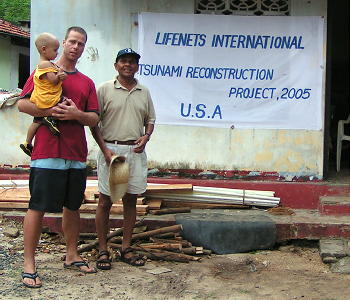
Kevin Fiske holding son Ethan along with Mark
Ranchigoda
Progress Report, 07/04/05
So far, the concrete slabs on the living level of two homes have been poured.
This will take approximately seven days to cure after which we will begin to
construct the walls with cinder blocks. From this point on, the rest of the
construction should be completed in about 65 days or so.
This week, the cinder blocks will be delivered to the job site, the masons are
supposed to arrive and the construction should commence on the block walls.
Simultaneously, concrete will be prepped and poured on the other three homes in
order to keep the project rolling.
Stay tuned for more reports from the construction site of our tsunami housing
project in Sri Lanka… .
 A view of the concrete at the living level
|
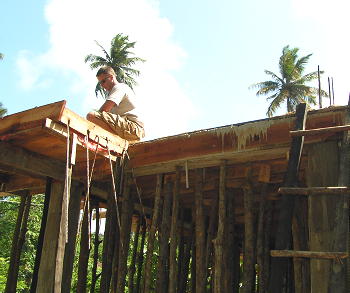 Kevin inspects the concrete at the living level structure |
July 3, 2005
LifeNets Assists Another Family in Need
In addition to our housing reconstruction project, LifeNets has sought various
ways in which to help tsunami victims attain some form of normalcy in their
lives. We achieve this through our livelihood development initiatives – helping
families to re-establish their respective trades or aid in establishing some
type of income generation.
So far, we have helped a local photographer and welder achieve self-sufficiency
by jump-starting their businesses. We have launched yet another micro-enterprise
effort – to help a disabled and tsunami-affected family in desperate need of
some income. 35-year-old Lasith, husband and father, is entirely hearing
impaired. His family lost most of their clothing and meager possessions when the
tsunami attacked.
|
|
|
Since their home is currently uninhabitable, they are living with area relatives
until Lasith can afford to be out on his own. Before the tsunami, Lasith was
accustomed to helping his local villagers with sporadic odd jobs; patching up a
leaky roof, carpentry work, masonry, and tile work. It was Lasith’s greatest
desire to establish a more substantial and stable trade so that he may support
his family throughout.
We are happy to make his dream a reality. LifeNets has been able to purchase a
complete set of supplies for Lasith to start a small tile work business.
Despite his disability, he is very skilled at this trade and believes he can
generate enough income to re-start a normal life for his wife who is also deaf,
and three kids, Ravindra aged 9, Nepchuan, aged 4, and little Kavisha a mere 9
months old.
We will keep you updated of Lasith and his family’s welfare in our future
progress reports….
Supplies Purchased for Lasith
1. Grinder
2. Drill
3. Cutter
4. Tile Snapper
5. Square
6. Pliers
7. Trowel
8. Spade
9. Rubber Mallet
10. Small Level (2 foot)
11. Tape Measure
12. Extension Cord (25 foot)
13. Dust Mask
14. Knee Guards
15. Safety Glasses
16. Bucket
June 21, 2005
Labeema Relief Camp
In between our time spent at the job site in Polhena, we are often compelled to
return to the many men, women and children enduring camp life. Each visit
provides many insights into the various psycho-social issues so common among
many tsunami victims. Apart from their grief and struggle to come to terms with
their losses, they suffer from numerous post-tsunami stress disorders.
Constant nightmares, eating and sleeping disorders, suicidal thoughts, and
feelings of alienation from society continue to plague them almost 6 months
past.
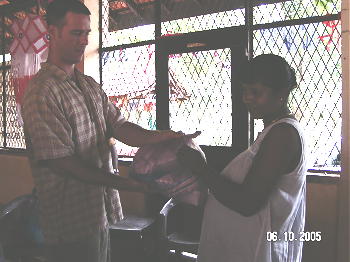 A harsh reality - many pregnant women endure camp life
They are so happy to received visitors to their lonely camp! |
 Through the eyes of a child...their expressive drawings relate the hardship endured
A widower, and his two children receive donations from Levi Hemingway |
We recently visited a small relief camp in the village of Labeema along with our
visitors from Arizona, Tim Fiske, his 11-year-old son Kile, Eric Hemingway and
son Levi, aged 9. In Labeema, over 15 families abide in wooden huts, sharing a
space of about 1600 square feet. Here, we met a father of two small children who
lost his wife; a mother mourning the death of her teenaged daughter; and a boy
orphaned by the tsunami’s instant devastation. We can scarcely contain our
sorrow, yet we quietly absorb each of their tearful accounts of that horrible
day.
We were also able to present each family with a care package, full of essential
items provided by the National Housing Development Authority. Each parcel
consisted of: flour, rice, lentils, canned food, 1 bed sheet, 1 towel, and a bar
of soap. With each visit, we are faced with the inevitable and painful task of
having to leave the relief camp and head home. They, as well as us, can hardly
wait for our return.
Kevin and Sonali
June 17, 2005
Progress Report, 06/17/05
We have some very exciting news to share concerning Sunil, Kusumali and their
children! You may remember them – the welder and his family who lost virtually
everything after the tsunami and have continued to endure living in interim
shelter for the past five months (see blog update below, dated 5/06). In
addition, Kusumali suffered the loss of her father and grandmother that fateful
day. She is still struggling to recover from her tragic loss.
Since the after effects of the tsunami, Sunil has been fervently attempting to
revive his livelihood, so that he could start a renewed life for his family. You
see, the temporary “food basket” currently offered by the government is no
longer sufficient to sustain a family of six. Ultimately, Sunil knew he needed
to restore his business so that his children could return to a relatively normal
life. He also hopes that by achieving self-sufficiency he may ultimately extend
help to his surrounding neighbors and villagers.

Sunil and his family are all
smiles--thankful
Taking in Sunil's
hospitality following |
Unloading all of Sunil's supplies |
LifeNets supporters Tim Fiske and Eric Hemingway, currently in Sri Lanka, upon
hearing Sunil’s plight, immediately offered to help him restore his welding
business. They hurriedly appealed to their friends and family in the U.S., and
in 3 short weeks collected enough funds to help purchase the essential welding
supplies for Sunil.
With their help, we have purchased all the necessary materials needed for Sunil
to commence work (See supply list below)! When it came time to hand-deliver the
supplies, it gained widespread attention among the villagers – so much so that
it captured the attention of the local new media.
As a genuine gesture of thanks, we were invited to Sunil’s modest home for a
taste of king coconut and traditional sweetmeats. Sunil was filled with
gratitude and appreciation for the donations he received. We were all truly
touched by the warmth and hospitality extended toward us by his engaging family.
LifeNets donated the following supplies to re-establish Sunil’s welding
workshop:
· Oxygen Tank Gauge
· Acetylene Tank Gauge
· Oxygen Wire Set
· Oxygen Torch
· Acetylene Tank
· Arc Welding Unit, 250 Amps
· (Dewalt) Metal Cut-off Saw
· Grinder
· Floor Drill Press
· Bench Drill Press
· Hand Drill
· Bench Vise
· Box Panel Set
· Set of Keys
· Socket Set
· Pop Rivet Machine
· Paint Spray Gun
· Hacksaw
· Set of Screwdrivers
· Face Shield/Mask
· Protective Gloves
June 10, 2005
This week, we have been fortunate to welcome a few of LifeNets supporters to Sri
Lanka. Kevin’s brother, Tim Fiske and friend Eric Hemingway traveled from
Arizona, U.S.A. to witness our tsunami reconstruction project first-hand.
While in Matara, they lent us a hand on the construction site. They were able to
achieve the time-consuming task of laying ˝ inch rebar in preparation for the
pouring of concrete. The first-story concrete columns have cured and ready for
the living level to be primed for the second phase of concrete. The concrete
slab will be 4 inches thick and 9 inches at the bond beam.
They laid over 100 steel rebar as 8” grids in preparation to pour the concrete
on the living level of the house. First, red plastic was laid down on top of the
plywood form boards and the rebar was laid on top of that. The red plastic
prevents the concrete from sticking to the form boards, so they can be reused.
Being resourceful is a necessity here – no material is ever wasted or discarded.
They will repeat the process on the other four houses so that the hand-mixed
cement can be poured on Monday.
Kevin and Sonali Fiske
 Laying the plastic to protect the plastic form boards
Tim Fiske, Kevin Fiske and Eric Hemingway laying rebar |
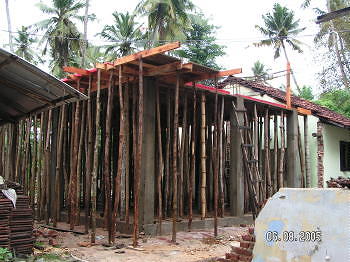 Stick braces are placed to hold the concrete
Tying the bond beam to the columns |
June 5, 2005
There are so many tsunami victims still lying in
tents, interim shelters and various relief camps throughout the country. Although
the reconstruction efforts are prodding on at a moderate pace, so many families
still lie in wait. While their permanent homes are being constructed, many
victims anxiously linger by the roadside for the random sight of NGO trucks
bearing food supplies.
LifeNets had the opportunity to assemble care packages for some of these people.
We were able to distribute powdered milk and flour to over 1,000 victims located
on a hillside within the grounds of a Buddhist temple in Matara.
Despite their hardship and obvious shortcomings, it was amazing to witness their
sheer gratitude for the few donations we brought them. For instance, last week,
a smaller, locally based NGO contributed kitchen utensils, comprising of a fork
and spoon per family. Although that may not appear as much, the people gratefully
accept whatever was given. As one refugee so profoundly shared: “ We take so
much for granted when things are going well; when we lose everything we value
everything.”
Kevin and Sonali Fiske
|
|
|
May 27, 2005
During the course of our project, we encounter so many victims who have been virtually stripped of everything – from their family members to every stitch of clothing they own. Although LifeNets is not in a position to help every victim encountered, we attempt to help those we can.
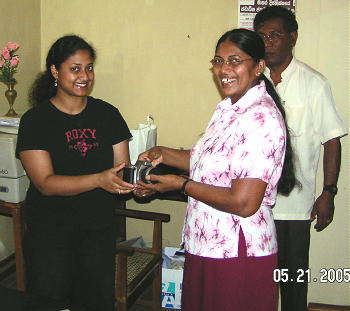 Mrs. Yapa receives her camera |
One such victim in need is a widow and mother named
K.R. Yapa. She was running a modest photography business out of her home. It was
a small-scale operation – a tiny storage room as her “studio,” an old Nikon
FM10, 35 MM camera with an electronic flash, some film and a few poor folk in
the village that needed to capture wedding or birth memories. It was an outdated
camera, but technology doesn’t advance all that hastily here as it does in the
West.
On December 26, she was stripped of everything she owned, including her
cherished camera. Although the tsunami tore through her house, it spared the
home’s main structure and merely damaged a few walls and windows. She is grateful
to not have to endure the relief camps. “I am thankful I still have my own roof
and the loving embrace of my children,” she tells us.
Mrs. Yapa’s priority was to restore her livelihood – just so she could purchase
food for her family. But to save enough funds to purchase a camera would take
her up to a year – she couldn’t achieve this without outside help. LifeNets is
happy to help Mrs. Yapa restore her home business! We have provided her with a
2003 model, Nikon FM 55, 35 MM camera with a built-in flash and tripod. Her face
lit up and tears filled her eyes as she gently held our donation in her hands.
As she gingerly placed the camera in her crumpled bag, she relates, “I never
expected such a beautiful camera… all I anticipated was a disposable at best.”
For certain, moments like these are the definite rewards of our mission here in
Sri Lanka.
May 20, 2005 Progress report
As reported last week, the foundations have been set on all five houses. In addition, the concrete reinforced stilts have been poured and they will be allowed to cure over the next few days. Today, the columns’ wooden form boards were removed and prepared for the all-important second stage of building – constructing the first floor, concrete platforms.
.jpg) Concrete Columns are up! |
.jpg) Colorful Buddhist flag |
Another significant Buddhist holiday is upon us.
Vesak, the commemoration of Buddha’s birth, enlightenment, and passing into
nirvana, is a colorful two-day celebratory journey. Predominantly kept in
Southeast Asia, vibrant processions take place in the temple, bodhi trees are
sprinkled with scented water, lanterns are lit, and street stalls are erected.
Children take to the streets in multi-colored costumes, waving festive flags and
paper lanterns.
.jpg)
Workers removing form boards
In our case, the workers on our job site are given the opportunity to go home to their individual villages, visit their families and celebrate Vesak in style. They have spent the last month or so, living in an abandoned building adjacent to our job site. This short, 3-day work break is a much-welcomed rest for them.
Kevin and Sonali Fiske
May 14, 2005
We are whistling while we work on the job site in Polhena, Matara! So far, the concrete has been poured for the foundations on all five houses. We are all hurriedly working in pursuit of the project deadline. As of this date, we have a total of 20 workers on onsite. Despite the archaic hand tools and conventional equipment available to these men, we are truly amazed at the progress being made!
.jpg) Achieving a level line using a plastic tube with water |
.jpg) Ethan Fiske - Sri Lanka's youngest tsunami relief worker |
For instance, the required concrete for our project is mixed by hand using raw materials. Truckloads of sand, gravel, and cement are delivered onsite and the workers laboriously mix the cement using buckets of water hand-carried onsite. They do not have the ease of a cement mixer, ready mix truck, or water hose as readily available in the U.S. Rebar is cut using a hacksaw, cement is mixed with a shovel, and necessary wood is cut with the use of a hand saw. There are no powered tools on hand!
Despite the lack of modern conveniences, remarkably, they work cohesively together and possess an incredibly resourceful work ethic. We’re very encouraged that we can achieve the proposed completion date of 3-5 months. Stay tuned for more exciting reports from the field!
.jpg)
Workers sawing wood with handsaws
May 6, 2005
As the rebuilding efforts prod on the plight of those victims still lying in refugee camps is of prime concern to those involved with the rehabilitation efforts here. The common talk among everyone concerned is that restoring Sri Lanka takes second place to providing housing, clothing and feeding the multitudes still languishing in various “tent villages” along the coastline. The ongoing predicament of over a half a million displaced people is a serious one, and of those victims, it appears that the children are both the most affected and tenacious among them.
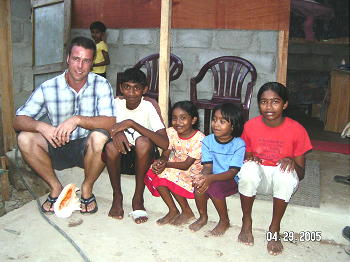 Left to Right - Kevin with Chamaka, Chaturni, Kaushaliya, and Ruwani-350 |
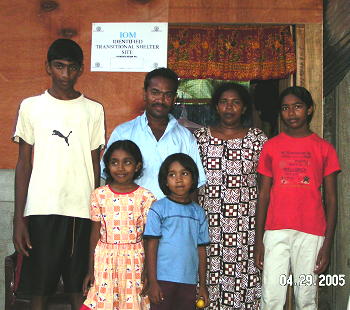 Sunil's beautiful family350.jpg |
Take Sunil, Kusumali and their children for example. With four children in tow – Chamaka, 16; Ruwani, 13, Kaushaliya, 10; and Chaturni aged 6, they eked out a meager existence albeit living a simple and contented life by the shores of Polhena. They currently live close to our work site and we often look forward to visiting them on our work breaks.
Within their small property, Sunil ran a welding business. His earnings barely enabled him to purchase the necessary textbooks needed to send his children to school. In order to supplement their income, Kusumali often sold coconuts to neighboring villagers or bartered for rice, oil or mangoes. In other words, Sunil and Kusumali were making do. Their situation makes it apparent, that those hardest hit by the tsunami were hit-hard to begin with.
On that fateful morning, inexplicably, Sunil and his family were spared their lives. His oldest son suffered deep wounds on his right thigh and foot from oncoming debris, while Kusumali suffered lesions on her arms while dangling from a coconut tree. They were stripped of all their modest possessions. All that remained were the clothes on their back.
Their next unsettling weeks ahead were spent at a Buddhist temple, a preschool, and an abandoned building respectively. Two months following the disaster, a foreign NGO granted them interim housing, a constricted 10 by 15 foot shelter, devoid of electricity or running water. As we entered their “home,” the children greeted us with vibrant smiles and laughter. Despite their hardship and the numerous psycho-social issues prevalent among tsunami-affected children, there was no evidence of it here.
Although they currently live a hand-to-mouth existence and survive on morsels of rice and lentils obtained from the 50 dollar monthly stipend supplemented by the government, they possess a remarkable outlook on their situation. With their hope still intact, Sunil relates “We don’t know why we have been chosen to live… we are grateful to have all of our children with us.” When they hear our footsteps towards their shelter, the children amusingly bound towards us with shouts of laughter. Little do they know the sheer pleasure we feel in seeing their charm
April 29, 2005
We are making good progress on stage one of our housing reconstruction project
in Polhena, Matara. Although we have had a few rain spells and two public
holidays back-to-back, the project is advancing well. The pillar footings on two
houses have been dug. Today, the rebar, is being sized and formed in preparation
for pouring concrete for the foundation.
A rapid production line will begin work on the remaining houses until all five
reach completion. Along with up to 12 laborers on hand, we have a construction
contractor, an on site supervisor, and an assistant engineer of the National
Housing Development Authority (NHDA).
 Mrs. Evanona and Sonali Fiske
The beautiful shores of Polhena |
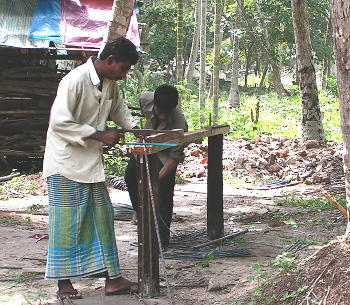 Laborers size the rebar
Mrs. Evanona's temporary wooden hut
|
The village of Polhena, an idyllic beach setting, is well known among travelers
as a diving and tourist haven. Although a beautiful coral reef protects its
shoreline, Polhena suffered extensive damage from the tsunami. Along with
structural damages incurred up to 80 per cent, fractured sewage lines and a
massive accumulation of debris on the shallow seabed contaminated its coastline.
Furthermore, the sand has shifted below the waterline, making it treacherous
underfoot.
Specifically related to our housing project is the issue of sand extraction. The
monumental construction efforts to re-house almost a million displaced people
will require massive amounts of sand. Residents of Polhena have already
witnessed the erosion resulting from sand removal after the tsunami.
While there are many such post-tsunami problems in existence, the country is
doing its best to deal with the crisis. Although the ecological threats are
clear, housing those victims still lying in interim shelter is taking obvious
precedence. Many such victims are tiring of tent living and long to be with
their children separated from them in several relief camps and/or living with
various relatives and Good Samaritans in the area.
LifeNets is able to assist several such affected families. Mrs. Evanona of
Polhena, Matara is one such recipient. Mrs. Evanona, her husband and children
lost their home and all their belongings from the onslaught of the tsunami. What
little they did have, comprising of three beds, scarce furniture, and precious
photographs taken at birth were all washed away within an instant. Her husband
suffered permanent hearing loss while hanging onto the limb of a Del tree,
waiting for the water to subside.
As dire as their situation is, it doesn’t describe the full extent of their
distress. You see, Mrs. Evanona suffers from breast cancer. It is her deepest
hope that despite what her future holds, her children may live together, under
one roof – a place to call their own. As she spends her time laying on a coarse
bed, within the make-shift walls of a bare wooden hut, our laborers are
hurriedly working outside – sanding, sawing and preparing materials to build
Mrs. Evanona the permanent refuge she so deserves. As we observe them work, she
tells me “I am the fortunate one. At least I’m alive and my children are safe.
What more could I ask for?”
April 20, 2005
We've included three
articles from three different local newspapers featuring our project. They
are variations of the same information, however I wanted you to see the kind of
exposure LifeNets is receiving here.
Also, I've included another article addressing the situation of fishing vessels.
I thought it might be helpful for those who are wondering why we've taken a turn
into providing housing.
The project is progressing very well over here
April 15, 2005
The following is our report covering the launch of
LifeNets Rebuilding Project for the victims of the tsunami. On Thursday, April
07, we traveled to Matara, approximately four hours south of Colombo, the
country’s capital. Located in a small fishing hamlet called Epitamulla, we
officially broke ground on building five dwellings for those victims whose homes
directly stood within the tsunami’s path. We toured the site of their former
houses – all that remain are heaps of rubble and debris, disfiguring any
resemblance of a dwelling these people once called “home.”
The morning began with an auspicious ceremony attended by most of the locals
within the community, the architect and engineer of the National Housing
Development Authority (NHDA) and the Deputy Minister of Housing, Mr. Ariyasena
Gajadeera. Also present was the local news media, comprising of 3 newspaper
journalists and cameramen from Rupavahini – the country’s national TV news
station.
.jpg)
Kevin and Ethan Fiske beside official LifeNets banner
%20(Custom).jpg) House plans submitted by NHDA Engineer
Kevin Fiske lays the official foundation stone
Signing the contract and other papers |
.jpg) Kevin and Sonali Fiske alongside project beneficiaries
Sonali Fiske talking to reporters about LifeNets project
Visiting one of the many temporary relief camps |
The ritual enabled the homeowners to give thanks to their donors, open the
process in prayer, and lay the ceremonial cornerstone of each individual house
to be built. Then, as a gesture of gratitude and warmth, we were invited to a
traditional meal of milk rice and bananas. Sri Lanka is a country steeped in
tradition and as such, it was very enriching to be a part of this practice and
watch it unfold before us.
The Housing Minister, Mr. Gajadeera, then proceeded to greet all attendees and
formally introduced LifeNets to all those present. He encouraged the surrounding
community to participate in the rebuilding project and asked that they pledge
their full support towards LifeNets. We then proceeded to sign the official
Memorandum of Understanding (MOU), which outlines the terms of our housing
project.
Some of the details of the MOU agreement are as follows:
· LifeNets will bear the cost of construction up to $3,500; the government will supplement a further $1,750 for add-on’s and furnishings
· A blue print was furnished for the construction of each house
· The NHDA will play a supervisory role during construction
· The date of completion will be between 3-5 months
· We placed an initial deposit of $2,250 to seal the deal
Overall, everyone was very accommodating and the ceremony was a great success.
Incidentally, we appeared on this evening’s news! It will be a great boost for
LifeNets and we feel it helps establish an official presence in Sri Lanka among
the gang of other NGO’s that are here. For instance, within our surrounding
building site, there are two other humanitarian envoys from Italy and Hungary.
We will make every effort to obtain a copy of the film footage and send it to you.
Further, we’ve been told an article may appear in the Sunday newspaper.
If so, we’ll be sure that too.
Well, that's a wrap.
Sonali
April 7, 2005
Kevin and Sonali Fiske are getting right into our reconstruction project. We are building a 36 foot boat that will benefit ten fishing families. We are also building five homes that were destroyed for fishing families. Each will be about 650 square feet. We have stayed away from the very small oru boats. After the devastation a great supply was delivered because they are cheap. However, there are too many of them in the shallow waters and territorial issues along with overfishing and territorial issues are becoming a consideration. The oru boats only net about $60 a month income for the fisherman. The larger boat is able to go further off the coast and stays out longer. This benefits more fisherman by doubling the monthly incom per fishing family. We feel we've made the best choices of what is REALLY NEEDED. Thanks to everyone's support! Here's Kevin and Sonali's latest report:
March 30
We’re off to a great start!
LifeNets will provide a fishing boat to benefit ten fishermen and will then
proceed to build five homes for tsunami-affected families.
We have met with Dr. Nalinda, who is the Personal Advisor to the Deputy Minister
of Fisheries and identified ten fishermen in dire need of a vessel. Within the
next few days, we will begin construction on a 36-foot, fiberglass resin boat,
locally known as a Madalle Walam. The boat will be managed as a co-op, within
the village and will be collectively owned by these men (Many of the rural
villages in Sri Lanka operate as co-operative societies).
We will oversee and participate in the entire manufacturing process, ensuring
LifeNets name/logo is conspicuously placed on its hull. The entire cost,
inclusive of materials, labor, engine, and fishing gear totals $4,500. This will
be a great outcome considering the boat will benefit ten families at once.
%20Site%20of%20basic%20homes%20-%20Matara%20District%20(2).jpg) Site of basic homes in the Matara District
Fisherman with destroyed 19 foot flat bottom boat |
%20Site%20of%20basic%20homes%20for%20victims%20-%20Payagala%20(2).jpg) Site of basic homes for victims in Payagala
Over-supplied oru boats |
The boat will set sail under a small ribbon-cutting ceremony. Also present will
be the district Grama Sevakaya (village chief), a representative from the
Ministry of Fisheries, and a local reporter. We will send you a special field
report and related photographs of the ceremony.
On Thursday, April 7, we will launch phase two of our Reconstruction Project –
the building of homes for the tsunami victims. Located in Polhena, within the
Matara District, these fisher families’ homes will be built well within the
300-foot tsunami buffer zone ordinance. We have met with the Housing Authority
Minister and will proceed to sign the essential Memorandum of Understanding (MOU)
outlining the building specifications and project terms. We will then meet with
the individual homeowners to sign contractual agreements with them as well. It’s
a process, but all these documents are essential to ensure there aren’t any
issues later on.
We will break ground by Friday, April 8, following an auspicious ceremony, as is
the formal custom and tradition in Sri Lanka. The construction of all five
houses will simultaneously commence by then. A LifeNets project banner will be
positioned at the entrance to the building site. The cost to build each house
inclusive of building materials and labor amounts to $3,500 – that’s less than
what we proposed in our last progress report.
Once we return from Matara on Friday, April 8, we will send you some along with
our next report.
March 30, 2005
.jpg) |
.jpg) |
We completed an interview for a documentary, hosted by 1993 Miss Australia, Shivaune Christina. Masoud Farand an Afghan/American filmmaker, who seeks to make a documentary about the post-tsunami efforts, came to Sri Lanka last week to document the devastation and formulate his story. He will be returning to the U.S. in a few days, edit the piece in two short weeks and proceed to sell it to the network stations. It will be an excellent promotional tool for LifeNets. Our son Ethan is shown in the photo with Shivaune and Massoud.
March 29, 2005
An 8.7 magnitude earthquake hit again in the Indian Ocean. We were very concerned about Kevin and Sonali in Colombo, Sri Lanka....we have just heard from them on email
|
March 27, 2005
Our experience at ground zero Sri Lanka's Tsunami Zone
We weren't fully prepared to accept what our eyes beheld as we approached the
tsunami zone in Southern Sri Lanka. Three months later, the remaining ruin
appears as much as it did on CNN in the immediate aftermath of the Tsunami.
Although much of the debris has been cleared and the roads more accessible, there's
a lot left to do.
|
Here lies an irreparable boat along the shores of Payagala
|
Although victims still lie in relief tents supplied by the big name NGO's and
fresh water stations are positioned every mile, the rebuilding phase has
begun! Sri Lanka's government has accomplished a lot in supplying victims with
their immediate needs and they have dispelled the fear of waterborne disease. Many
kit homes are already under construction and the government hopes to have victims
adequately housed before the Monsoon season arrives.
With trepidation, we approached the villages, careful not to impede on the
victims small space of serenity they collectively share. One man built a
makeshift house 40 feet above in a coconut tree, fearing the tsunami's return.
They bombarded us with harrowing tales of a crashing 10-foot wave that ravaged
their lives, taking their children, few belongings, and homes of up to a mile
inland. Many of them lack sleep at night, fearing that the roaring waves within
earshot will ravage their villages once again. We gazed at them, teary-eyed and
sorrowful.
We found that some fisher folk have been given a fresh new start by various
organizations including a Belgian Army Unit whom we befriended. Similarly,
within the coming weeks, LifeNets will supply several affected fishing families
a vessel, in order to restore their livelihood and feed their children. We have
identified and personally met fishermen who are simply longing for such a rebirth.
It is our turn to extend our hearts and hands in aid and enable these men to charge
back out to sea-- what a privilege!
|
There are many such vessels dotted along the beach
A local fisherman in Kalutara attempts to make peace with the sea |
Beautiful Sri Lankan children biding time at one of the many interim relief camps
Oru boat |
Here's the latest, as of 11:33 a.m., Sunday, March 27....
Although the country has faced a humanitarian crisis, locals are so
matter-of-fact about what happened and display no sense of urgency about it.
Things proceed quite slowly in Sri Lanka, it's just the island-style, no
hurry approach. For instance, Friday was a monthly Buddhist mandatory holiday
and as such all government offices, banks, and municipalities were closed. Despite
that, and the slow pace here, we have achieved much towards our goal.
Here is what we have so far:
We made visits to numerous fishing villages including: Payagala, Kalutara,
Matara, Mirissa, and Galle. It was an eye-opening look into the folkloric
practices of local fishermen .
We met with the District Minister of Housing and Redevelopment in Matara, also
responsible for boat distribution. They will get back to us by Tuesday, March
29, with fishermen in the Matara District who are still in need.
We have found a boat manufacturer who has agreed to build each non-motorized,
two-man, Oru boat for approx. $450; a dramatic decrease in price from the
original quote of $750 in our original proposal! And, if we are able to place a
bulk order, we may receive a further discount. ETA on the construction of each:
approx. 9 days.
We will personally oversee and supervise the boat construction and intend to
take a hands-on role in sanding, finishing, and painting of vessels. Once
completed, each donated vessel will be affixed with LifeNets name and logo.
Following production, the ceremonial distribution process will be covered by the
local news media and each benefactor will receive a LifeNets document, certifying
their ownership and receipt of vessel. We hope to place an initial order within
the next 7 days.
Our next step:
Today, we will once again head out to Payagala where we have been told are some
fishermen in need. We will obtain official documentation from the Grama Sevakaya
(village chief) to ensure each boat goes to a fisherman who lost a vessel.
On Monday, we are meeting with the personal advisor to Sri Lanka's Prime
Minister. He compiles the most current, accurate, and reliable information on the
fisheries rebuilding efforts and of those still in need. Each fishermen having
lost his vessel, was told to file a police report and then was subsequently handed
a document of verification. From these documents we will know where our efforts
need to be placed.
Shortly thereafter we will schedule an informal meeting with the local USAID
office in Colombo. I will let you know the result of that.
As you can see, our path becomes clearer every day. There may be days
where production stalls and things aren't getting done as precisely and quickly as we'd like, however we are steadily making progress. Will report again soon¦.
March 21, 2005
Hello All,
We have arrived safe and sound in Colombo. We are feeling great, not jet-lagged at
all -- all's well. We are currently in search of an apartment for rent, which we
hope to have established by week end.
We will write again shortly with address and other contact details. Hope all is
well with you.
God bless.
Kevin and Sonali
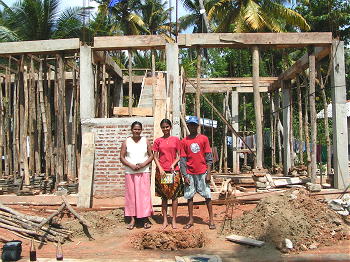
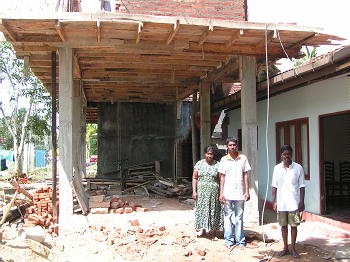
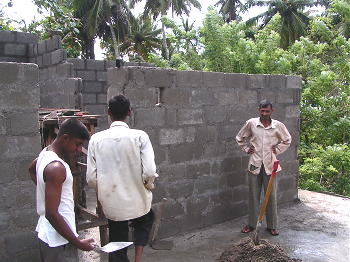
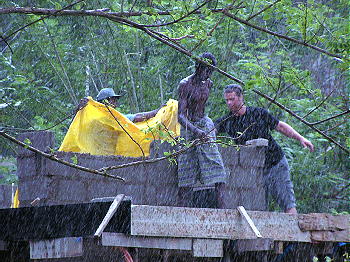
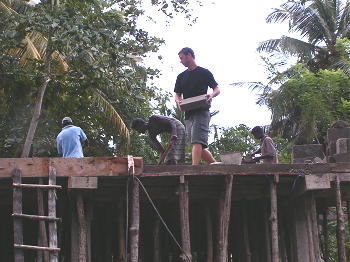
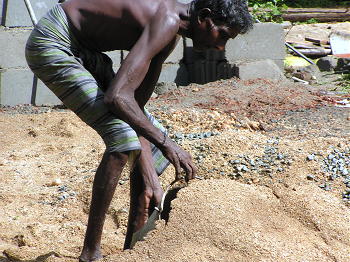



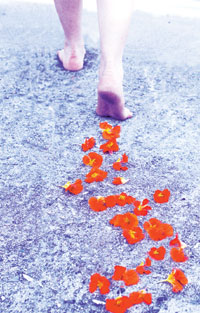


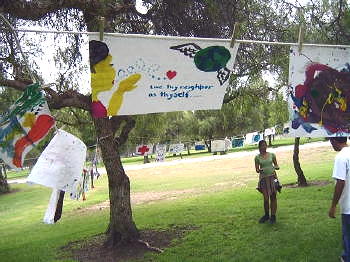




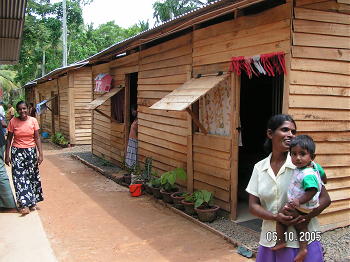



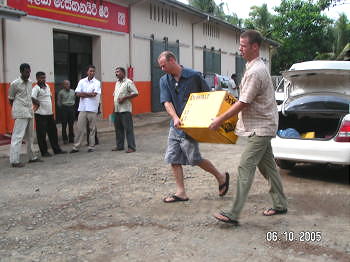



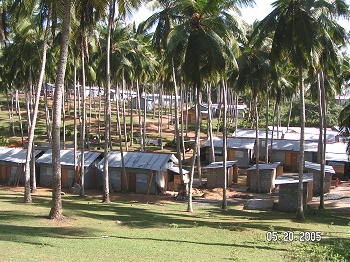
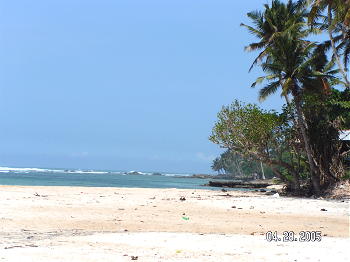
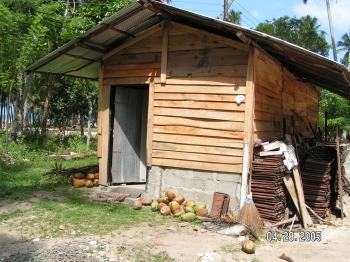
.jpg)
.jpg)
.jpg)
.jpg)
%20Fisherman%20with%2019-ft%20flat-bottom%20boat,%20destroyed-c%20(2).jpg)
%20Oru%20Boats%20-%20Over-supplied-c%20(2).jpg)
.jpg)
.jpg)
.jpg)
.jpg)
.jpg)